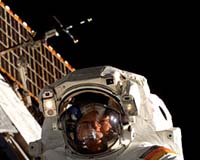 |
New Orleans LO (SPX) Jun 18, 2010 The Orion crew exploration vehicle took shape as the two halves of the crew module were fused together at NASA's Michoud Assembly Facility in New Orleans, La. The Lockheed Martin Orion team welded the forward cone assembly to the aft barrel assembly using the next generation friction stir weld process. The 445-inch long weld is the longest such weld of its kind and will ensure optimal structural integrity for the harsh environments of space flight. The completion of the crew module welds marked another key milestone for the Orion crew exploration vehicle, completing the structural framework of the spacecraft. All welds have met stringent quality requirements without any rework required. Prior to flight testing, this crew module will be tested on the ground in flight-like environments, including static vibration, acoustic, and water landing tests. Results will be used to correlate sizing models for all subsystems on the vehicle. Orion weld operations take place on a Universal Weld System II (UWS II) that includes a 22-foot diameter turntable, a self-reacting friction stir weld head and a modular t-grid floor. The system affords virtually unlimited five-axis welding on fixture-mounted hardware. The UWS II is part of the National Center for Advanced Manufacturing, managed by the University of New Orleans Foundation in partnership with NASA and the State of Louisiana. The friction stir welding process advances the state-of-the-art for circumferential welds, yielding higher strength and higher quality welds at a lower cost. The latest state-of-the-art manufacturing technologies, efficient processes and new materials, such as the ultra-light weight Aluminum-Lithium alloy, are all being employed on Orion to produce the lightest possible vehicle for space flight. "The combination of material and manufacturing advancements in technology are key reasons why the spacecraft is more lightweight and damage resistant than many industry experts thought possible," said Larry Price, Lockheed Martin Orion deputy program manager. "The balance of manufacturing methods and varied materials such as composites and advanced alloys that have been applied to Orion resulted in vehicle optimizations across the board - lowest cost, lightest weight, and improved structural integrity, which is critical to crew safety." Lockheed Martin is the prime contractor to NASA for the Orion crew exploration vehicle - the nation's next generation spacecraft for future exploration throughout our solar system. The Orion spacecraft is comprised of a crew module for crew and cargo transport; a service module for propulsion, electrical power and fluids storage; a spacecraft adapter for securing it to the launch vehicle, and a launch abort system that will significantly improve crew safety. The Lockheed Martin Orion Project office is based in Houston, Texas, near NASA's Johnson Space Center and leads the industry team that includes major subcontractors as well as a network of minor subcontractors and small businesses working at 88 facilities in 28 states. In addition, the program contracts with more than 500 small businesses across the United States through its expansive supply chain network.
Share This Article With Planet Earth
Related Links Lockheed Martin Space Tourism, Space Transport and Space Exploration News
 ESA Astronauts At ILA In Berlin
ESA Astronauts At ILA In BerlinParis, France (SPX) Jun 10, 2010 Ten past and present ESA astronauts will be at the ILA international aerospace show at Berlin's Schoenefeld on Friday 11 June. At the same time, ESA will continue its presence on its shared stand. ESA will participate in ILA's 'Spaceflight: Yesterday-Today-Tomorrow' workshop on Friday, starting at 12:00 CEST in the Space Hall (Raumfahrt-Halle). Former ESA astronauts Ulf Merbold and E ... read more |
|
| The content herein, unless otherwise known to be public domain, are Copyright 1995-2010 - SpaceDaily. AFP and UPI Wire Stories are copyright Agence France-Presse and United Press International. ESA Portal Reports are copyright European Space Agency. All NASA sourced material is public domain. Additional copyrights may apply in whole or part to other bona fide parties. Advertising does not imply endorsement,agreement or approval of any opinions, statements or information provided by SpaceDaily on any Web page published or hosted by SpaceDaily. Privacy Statement |